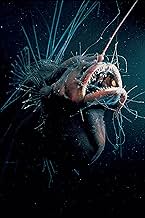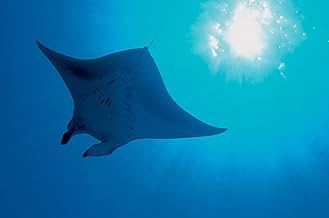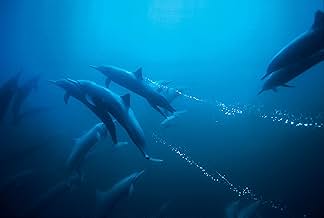IMDb RATING
7.4/10
3.2K
YOUR RATING
Join a voyage through aquatic realms where humans have rarely dared to go. Waddle with playful penguins, dart with lightning speed through schools of sharks, ride over stormy waves with mass... Read allJoin a voyage through aquatic realms where humans have rarely dared to go. Waddle with playful penguins, dart with lightning speed through schools of sharks, ride over stormy waves with massive whales and view rare alien-like creatures.Join a voyage through aquatic realms where humans have rarely dared to go. Waddle with playful penguins, dart with lightning speed through schools of sharks, ride over stormy waves with massive whales and view rare alien-like creatures.
- Directors
- Writers
- Stars
Pierce Brosnan
- Narrator
- (English version)
- (voice)
Michael Gambon
- Narrator
- (voice)
Frank Glaubrecht
- Narrator
- (German version)
- (voice)
Jacques Perrin
- Récitant
- (voice)
Dalik Wollinitz
- Narrator (voice: Hebrew version)
- (as Dalik Volonitz)
- Directors
- Writers
- All cast & crew
- Production, box office & more at IMDbPro
Featured reviews
I have just watched three hours of the Galapagos on the National geographic Channel, and am preparing to watch 11 hours on Planet earth on Discovery. What a joy to see this film, narrated by Pierce Brosnan in between.
Fi9lmed at the deepest ocean where no light can pierce, the colors and lights that are created by the inhabitants outshine any laser show that you can imagine.
This is the wonder and beauty of our planet at its best. I cannot imagine why we have to travel to other worlds, when we have this one waiting for us.
Fi9lmed at the deepest ocean where no light can pierce, the colors and lights that are created by the inhabitants outshine any laser show that you can imagine.
This is the wonder and beauty of our planet at its best. I cannot imagine why we have to travel to other worlds, when we have this one waiting for us.
The beginning of this documentary is devoid of credits. We see dolphins swimming and leaping in the open water and sea birds diving directly into the ocean to snatch a fish. The narrator (Pierce Brosnan) says, "This is a world of constant jeopardy, an endless cycle of birth, death, and renewal." Powerful waves crash into the rocky coast, where the sea lions return to give birth, but unwary seals become prey to predators (the black and white colored killer whales) in the shallows at high tide. Then again, the whales themselves risk being stranded there.
More marine life is seen before the view shifts to the coral reefs, "a narrow band of sun-fed life only found in the shallows of the tropical seas." The skeletons of coral polyps – the smallest and most fragile of organisms – form the reef. The darkness is feeding time for some; the night-feeders with built-in sensors have no need of light. Fascinating and colorful sea creatures abound further below the ocean surface, but unfortunately most are not identified. There are poisonous jellyfish and manta rays. Just before the halfway mark of the film the scene moves to the Arctic (polar bears) and also Antarctic (penguins). In the Antarctic the temperature is seventy degrees below zero (-70°F) and the winds exceed one hundred miles per hour. The penguins gather speed in the cold waters before jumping out and landing on sheet ice. Meanwhile in the far north the polar bears search for nesting seals hidden in ice caves situated just below the surface. Thirty-ton gray whales travel six thousand miles to feed in the polar seas. After six hours of jostling, killer whales separate one unfortunate gray calf from its mother and move in when it is thoroughly exhausted.
From the surface of the ocean we next enter a subterranean world, the deepest underwater area on the planet and where surface light does not penetrate. Seven miles deep (the Marianas Trench), it is a mystery world of perpetual night. It is a sparsely explored netherworld of odd life forms (again unidentified). The only light emanates from the undersea creatures themselves. Light is used as a lure to attract prey or as a decoy to confuse them. Poisonous hydrogen sulfide gas and boiling water spew forth in some areas. Yet, even near those settings some life forms exist. At film's end we hear that there are only a few thousand blue whales left on earth. The blue whales are earth's largest creatures by far.
The narration is limited and the orchestral music appropriate. If you like nature documentaries, you will enjoy this one, although there are several lulls.
More marine life is seen before the view shifts to the coral reefs, "a narrow band of sun-fed life only found in the shallows of the tropical seas." The skeletons of coral polyps – the smallest and most fragile of organisms – form the reef. The darkness is feeding time for some; the night-feeders with built-in sensors have no need of light. Fascinating and colorful sea creatures abound further below the ocean surface, but unfortunately most are not identified. There are poisonous jellyfish and manta rays. Just before the halfway mark of the film the scene moves to the Arctic (polar bears) and also Antarctic (penguins). In the Antarctic the temperature is seventy degrees below zero (-70°F) and the winds exceed one hundred miles per hour. The penguins gather speed in the cold waters before jumping out and landing on sheet ice. Meanwhile in the far north the polar bears search for nesting seals hidden in ice caves situated just below the surface. Thirty-ton gray whales travel six thousand miles to feed in the polar seas. After six hours of jostling, killer whales separate one unfortunate gray calf from its mother and move in when it is thoroughly exhausted.
From the surface of the ocean we next enter a subterranean world, the deepest underwater area on the planet and where surface light does not penetrate. Seven miles deep (the Marianas Trench), it is a mystery world of perpetual night. It is a sparsely explored netherworld of odd life forms (again unidentified). The only light emanates from the undersea creatures themselves. Light is used as a lure to attract prey or as a decoy to confuse them. Poisonous hydrogen sulfide gas and boiling water spew forth in some areas. Yet, even near those settings some life forms exist. At film's end we hear that there are only a few thousand blue whales left on earth. The blue whales are earth's largest creatures by far.
The narration is limited and the orchestral music appropriate. If you like nature documentaries, you will enjoy this one, although there are several lulls.
It's a very nice feeling watching a documentary like this on the big screen. You can feel the overwhelming power of waves bursting against rocky coastlines and experience the vastness of the ocean.
"Deep Blue" takes you on a journey from the coast to the coral reefs, then to the icy lands of the (ant-)arctic, and finally down to the most fascinating part of this movie: the deepest depths of the ocean, where not a single beam of light shatters through.
Most scenes are greatly composed of very clear, sharp and absolutely stunning images harmonized with the orchestral music of the Berliner Philharmoniker.
In one very nice and humorous scene where you see hundreds of fat penguins shambling over a sheet of ice, I nearly got the impression, also induced through the music, watching the marching scene of Edoras citizens in "Lord of the Rings, The Two Towers". Might sound odd, but I guess I have a faible for "large" scenes with many actors moving on the big screen, supported by a big orchestra. There is another scene like this with little crawfish on the coast choreographed like a sports event.
But in "Deep Blue" you have no special effects. There are literally thousands of "actors" in some scenes. You watch birds falling from the sky, shooting into the waters, grabbing one fish out of a vast swarm. You watch penguins gaining speed under water, jumping out and finally (more or less) safely landing with their round bellies on the sheets of ice. And you're worried about little fish hiding under rocks when carnivore fishes arrive searching for food.
You might have seen most of the animals before, but when they take you some kilometers down you enter a completely different and very fascinating world, which I have never seen before in another documentary - at least not in this clarity.
Down there in this seemingly live threatening environment very, very odd and sometimes scary looking creatures are lingering around. Sometimes you wonder yourself if they just dropped you out of the documentary throwing you right into a science fiction movie.
There are tiny creatures, partly transparent, with moving light bars on their bodies pulsating in rainbow colors. There are little ones generating bright flashes to baffle their enemies. And, well, if you've seen "Finding Nemo" you might recognize the scary looking carnivore with a "light bulb" on his head attracting innocent little fishies.....
So... I rated this documentary 8/10. It's not perfect in my opinion. There is a narrator sometimes throwing in some sentences which are more or less describing the current scene. I think he speaks about 10-15 times in the whole movie. This goes well with the pace and the atmosphere (would be disturbed by too much speaking), but gives you nearly no information about the animals you see on screen. A tiny subtitle in one of the lower edges might have been great showing you the names of the creatures you're currently looking at.
Also I would have done the cutting in a slightly different way. Some scenes are perfect, just beautiful and overwhelming, where other scenes are very much like in the usual TV documentaries.
Overall, this movie is worth watching in the cinema if you have the opportunity to do so. Also, the more people learn to admire the wonders of the ocean, the more chances mankind may have to protect it in the future.
"Deep Blue" takes you on a journey from the coast to the coral reefs, then to the icy lands of the (ant-)arctic, and finally down to the most fascinating part of this movie: the deepest depths of the ocean, where not a single beam of light shatters through.
Most scenes are greatly composed of very clear, sharp and absolutely stunning images harmonized with the orchestral music of the Berliner Philharmoniker.
In one very nice and humorous scene where you see hundreds of fat penguins shambling over a sheet of ice, I nearly got the impression, also induced through the music, watching the marching scene of Edoras citizens in "Lord of the Rings, The Two Towers". Might sound odd, but I guess I have a faible for "large" scenes with many actors moving on the big screen, supported by a big orchestra. There is another scene like this with little crawfish on the coast choreographed like a sports event.
But in "Deep Blue" you have no special effects. There are literally thousands of "actors" in some scenes. You watch birds falling from the sky, shooting into the waters, grabbing one fish out of a vast swarm. You watch penguins gaining speed under water, jumping out and finally (more or less) safely landing with their round bellies on the sheets of ice. And you're worried about little fish hiding under rocks when carnivore fishes arrive searching for food.
You might have seen most of the animals before, but when they take you some kilometers down you enter a completely different and very fascinating world, which I have never seen before in another documentary - at least not in this clarity.
Down there in this seemingly live threatening environment very, very odd and sometimes scary looking creatures are lingering around. Sometimes you wonder yourself if they just dropped you out of the documentary throwing you right into a science fiction movie.
There are tiny creatures, partly transparent, with moving light bars on their bodies pulsating in rainbow colors. There are little ones generating bright flashes to baffle their enemies. And, well, if you've seen "Finding Nemo" you might recognize the scary looking carnivore with a "light bulb" on his head attracting innocent little fishies.....
So... I rated this documentary 8/10. It's not perfect in my opinion. There is a narrator sometimes throwing in some sentences which are more or less describing the current scene. I think he speaks about 10-15 times in the whole movie. This goes well with the pace and the atmosphere (would be disturbed by too much speaking), but gives you nearly no information about the animals you see on screen. A tiny subtitle in one of the lower edges might have been great showing you the names of the creatures you're currently looking at.
Also I would have done the cutting in a slightly different way. Some scenes are perfect, just beautiful and overwhelming, where other scenes are very much like in the usual TV documentaries.
Overall, this movie is worth watching in the cinema if you have the opportunity to do so. Also, the more people learn to admire the wonders of the ocean, the more chances mankind may have to protect it in the future.
Liked "Winged Migration" and "Microcosmos," "Deep Blue" is a big-screen nature documentary patiently filmed over a period of years. As "Winged Migration" concentrated on the creatures of the air, so "Deep Blue" focuses on creatures of the sea. Reminding us how little we have explored the liquid space of our own oceans, the images here can be beautiful and graceful (dolphins playing in the surf), humorous (a mass of crabs laying eggs on the sand) as well as grim and deadly (killer whales attacking and eating seal pups). The moments of beauty are poignant indeed, and "Deep Blue" has it's share of "wow" moments. It divides itself into various themes; the shallows, the shoreline, the open seas, the polar seas, and the deep. The latter is shot near the deepest places on earth, and several creatures never before photographed are displayed in all their bioluminescent glory. The penguins shooting out of the ocean like biological missiles is quite amazing, and the feeding frenzy of the sharks is terrifying. Michael Gambon's narration is rarely intrusive, but it isn't as informative as I would have liked; they could have used some graphics to at least give you an idea of what creatures you were seeing, or where the shots were located. Still, this is a beautiful film, much of which was filmed for the "Blue Planet" BBC series. It looks frightfully gorgeous on the big screen, although parents should be warned that the seal pup death scenes can be terrifying to younger or more sensitive viewers.
We watched this film in school the other day. I thought that it would have just been some half-hour National Geographic special on the ocean, but it was actually a real movie. They showed us creatures at the bottom of the ocean, and more. The cinematography was excellent, and the music score was also well-done. It always fit with what was going on. It wasn't just some footage from Jaws 4 and an Australian-voiced cartoon character making shark jokes. It was a very well done film, and it was narrated by Pierce Brosnan of James Bond fame. I suggest renting it or something. Hope this review was helpful and all. I give Deep Blue an 8/10.
Did you know
- ConnectionsEdited from The Blue Planet (2001)
- How long is Deep Blue?Powered by Alexa
Details
- Release date
- Countries of origin
- Official site
- Language
- Also known as
- Đại Dương Xanh Thẳm
- Filming locations
- Production companies
- See more company credits at IMDbPro
Box office
- Budget
- $5,000,000 (estimated)
- Gross US & Canada
- $132,261
- Opening weekend US & Canada
- $8,373
- Jun 5, 2005
- Gross worldwide
- $19,292,539
- Runtime1 hour 23 minutes
- Color
- Sound mix
- Aspect ratio
- 1.85 : 1
Contribute to this page
Suggest an edit or add missing content
























